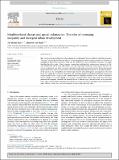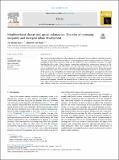Files in this item
Neighbourhood change and spatial polarization : the roles of increasing inequality and divergent urban development
Item metadata
| dc.contributor.author | Modai-Snir, Tal | |
| dc.contributor.author | van Ham, Maarten | |
| dc.date.accessioned | 2018-10-11T15:30:06Z | |
| dc.date.available | 2018-10-11T15:30:06Z | |
| dc.date.issued | 2018-12 | |
| dc.identifier | 253147621 | |
| dc.identifier | 9b20b12c-37a3-44c9-af88-db68ebdfc5ce | |
| dc.identifier | 85047475430 | |
| dc.identifier | 000449896500012 | |
| dc.identifier.citation | Modai-Snir , T & van Ham , M 2018 , ' Neighbourhood change and spatial polarization : the roles of increasing inequality and divergent urban development ' , Cities , vol. 82 , pp. 108-118 . https://doi.org/10.1016/j.cities.2018.05.009 | en |
| dc.identifier.issn | 0264-2751 | |
| dc.identifier.other | ORCID: /0000-0002-2106-0702/work/64697508 | |
| dc.identifier.uri | https://hdl.handle.net/10023/16192 | |
| dc.description | This project has received funding from the European Union’s Horizon 2020 research and innovation programme under the Marie Sklodowska-Curie grant agreement No. 702649; and from the European Research Council under the European Union’s Seventh Framework Programme (FP/2007-2013) / ERC [Grant agreement No. 615159] (ERC Consolidator Grant DEPRIVEDHOODS, Socio-spatial inequality, deprived neighbourhoods, and neighbourhood effects). | en |
| dc.description.abstract | Most studies of neighbourhood and urban change do not distinguish between different underlying processes. This study distinguishes between the effect of increasing inequality between neighbourhoods and the effect of exchanges in their relative positions which can be attributed to urban development processes. The paper identifies the relative roles of these processes in generating neighbourhood socioeconomic change in the Tel-Aviv metropolitan area in Israel, and analyses how they interacted in reshaping its socio-spatial structure. Tel-Aviv is an interesting case study because of a persistent north-south socioeconomic divide. During the research period (1995–2008) inequality in Israel has risen substantially following the integration in the global economy; at the same time, the metropolitan area went through extensive urban development and expansion to the rural fringe. To examine the contributions associated with increasing inequality and urban-development processes to neighbourhood income change we use a method that was originally presented in the context of individual income mobility and recently applied in the context of neighbourhood change. The results show that urban processes and inequality intensified the historical divide in different ways, and each factor can be associated with a typical spatial pattern. The interaction between the factors is diverse; in some places they reinforced each other, whereas in some they operated at opposite directions and offset each other. | |
| dc.format.extent | 2151146 | |
| dc.format.extent | 2150545 | |
| dc.language.iso | eng | |
| dc.relation.ispartof | Cities | en |
| dc.subject | Neighborhood change | en |
| dc.subject | Socioeconomic change | en |
| dc.subject | Spatial polarization | en |
| dc.subject | Socio-spatial structure | en |
| dc.subject | Inequality | en |
| dc.subject | Socio-spatial divide | en |
| dc.subject | GF Human ecology. Anthropogeography | en |
| dc.subject | HN Social history and conditions. Social problems. Social reform | en |
| dc.subject | 3rd-NDAS | en |
| dc.subject.lcc | GF | en |
| dc.subject.lcc | HN | en |
| dc.title | Neighbourhood change and spatial polarization : the roles of increasing inequality and divergent urban development | en |
| dc.type | Journal article | en |
| dc.contributor.sponsor | European Research Council | en |
| dc.contributor.institution | University of St Andrews. School of Geography & Sustainable Development | en |
| dc.identifier.doi | https://doi.org/10.1016/j.cities.2018.05.009 | |
| dc.description.status | Peer reviewed | en |
| dc.identifier.grantnumber | ERC-2013-CoG | en |
This item appears in the following Collection(s)
Items in the St Andrews Research Repository are protected by copyright, with all rights reserved, unless otherwise indicated.


